To use live scan fingerprinting software effectively, you’ll first need to understand its basics, such as capturing digital fingerprints and transmitting them for background checks. Choose equipment certified by the FBI and software that integrates well with your scanner. Leverage features like automatic data updates and customizable workflows to streamline processes. By optimizing these tools, you can enhance efficiency and accuracy. Continuing to explore these strategies will help you maximize the benefits of live scan technology.
Understanding Live Scan Fingerprinting Basics
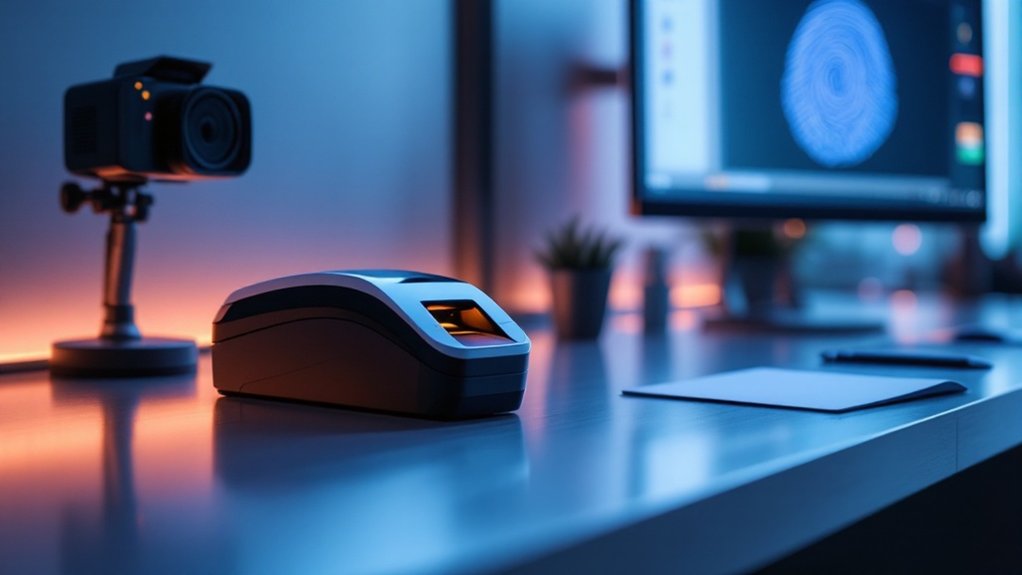
How do you effectively utilize live scan fingerprinting? Start by understanding that it’s a digital method of capturing fingerprints electronically, offering higher accuracy and faster processing than traditional ink methods. You’ll place your fingers on a glass plate of a scanner to capture digital images, which are then transmitted electronically for background checks, professional licensing, and immigration processes.
As you engage with live scan fingerprinting, you’ll benefit from its ability to provide cleaner results, reduce human error, and enable rapid processing. This technology is continuously evolving, ensuring compatibility with law enforcement systems and a seamless user experience. By leveraging these advantages, you can efficiently manage fingerprinting needs while ensuring security and accuracy. Additionally, live scan fingerprinting is particularly effective because it captures unique patterns, including fingerprint ridges, which are essential for accurate identification.
Choosing the Right Live Scan Equipment
When choosing the right live scan equipment, you need to make sure several key factors are considered. First, verify that the equipment is certified by the FBI IAFIS and complies with relevant standards to guarantee compatibility and data integrity. Additionally, examine the type of scanner technology, such as optical or capacitive, and the software’s ability to integrate with various models and facilitate real-time quality control and electronic submission.
Key Equipment Features
Choosing the right live scan equipment is essential for effective fingerprinting services. You need equipment that complies with FBI standards, such as IAFIS and Appendix F, ensuring interoperability with law enforcement systems. LES film-based sensors offer superior performance and security by requiring skin conductivity, which helps prevent spoofing attacks. Your equipment should support both rolled and flat scans to meet various agency requirements. High-resolution scanners are imperative for accurate fingerprint images, and mobile equipment enhances convenience by allowing on-site fingerprinting. Additionally, look for user-friendly interfaces, secure data transmission, and software compatibility with multiple scanner models.
Choosing Equipment
Selecting the right live scan equipment is critical for delivering efficient and accurate fingerprinting services. You should guarantee that the equipment is certified by the FBI IAFIS to confirm compatibility with law enforcement systems. Consider the portability of the equipment, such as Bayometric’s mobile solutions, for field-level use. Choose between optical, capacitive, thermal, or ultrasound scanners based on your specific needs. Also, select equipment with compatible live scan software for streamlined fingerprint processing.
When evaluating suppliers, assess their reputation, support services, and customization options. Ascertain they comply with relevant certifications and regulations. Opt for durable equipment that can withstand frequent use and harsh environments, and consider the cost-effectiveness of the equipment and services provided. The initial investment for starting a live scan business typically ranges from $4,000 to $6,000, which can be covered without relying on angel investors.
Selecting Compatible Live Scan Software
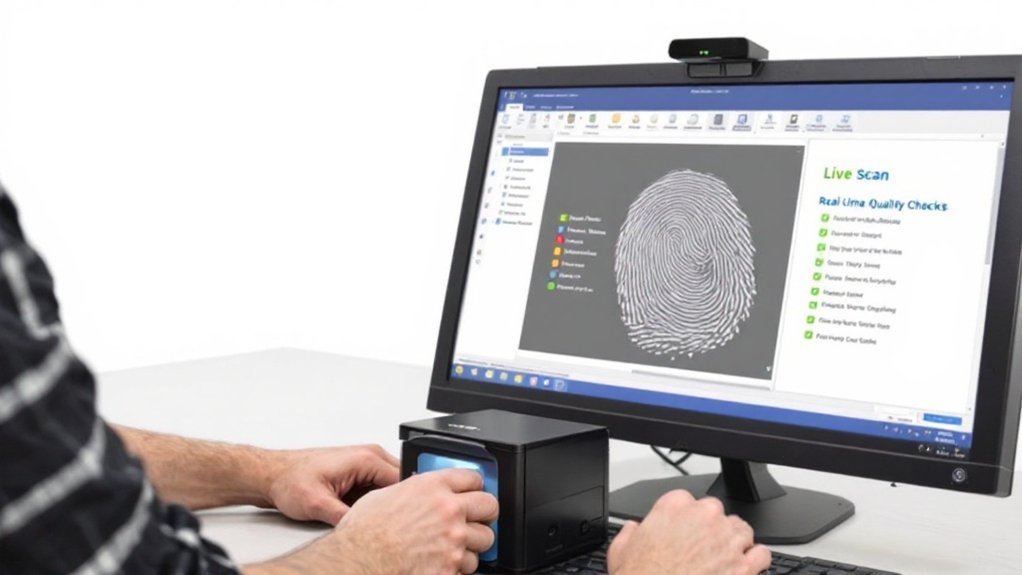
When selecting compatible live scan software, you need to guarantee it works seamlessly with a variety of fingerprint scanners, including those from Crossmatch/HID, Integrated Biometrics/IBT, Idemia, and Jenetric. The software should also be compatible with FBI-certified scanners to meet federal standards and offer flexibility in using different scanner types. Additionally, it’s essential that the software integrates well with various hardware options, adheres to industry standards like ANSI/NIST and FBI EBTS, and provides an intuitive user interface for efficient fingerprint capture.
Selecting Compatible Live Scan Software
To effectively utilize live scan fingerprinting software, you need to guarantee it aligns with your operational needs and regulatory requirements. This involves verifying the software is FBI IAFIS certified and compatible with various scanner models.
- Certification and Compatibility: Validate the software is certified by the FBI and works with multiple fingerprint scanners.
- Data Entry and Validation: Look for software with robust demographic data entry and validation checks to minimize errors.
- Operational Efficiency: Opt for software that supports electronic submissions and real-time quality checks for efficient workflow management. By focusing on these aspects, you can streamline your live scan operations and guarantee compliance with regulatory standards.
Software Compatibility
Guaranteeing that your live scan software is compatible with various fingerprint scanners is essential for a seamless fingerprinting process. You should look for software that supports models from Crossmatch/HID, Integrated Biometrics/IBT, Idemia, and Jenetric, as well as specific scanners like the Suprema RealScan G-10. Compatibility with these scanners allows you to choose the hardware that best fits your needs. Additionally, the software should adhere to industry standards like ANSI/NIST and FBI EBTS for fingerprint image quality and transmission. This verifies that your data meets federal requirements and maintains high quality. Effective live scan software also ensures that the process is digital and efficient, eliminating the need for traditional ink methods and providing faster results.
Key Features
Selecting the right live scan software involves evaluating several key features that enhance the efficiency and accuracy of the fingerprinting process. You need software that can automatically update data, provide preformatted fields for structured input, and allow customization to meet specific requirements. Here are some essential features to ponder:
- Automatic Data Updates: Upholds data consistency and accuracy.
- Configurable Data Input: Permits customization for state and federal regulations.
- Quality Checks: Real-time checks guarantee high-quality biometric images are captured. Effective live scan software also integrates well with FBI-certified scanners, ensuring compliance with federal standards. By focusing on these features, you can streamline your workflow and improve overall performance.
Effective Use of Live Scan Software Features
Effective use of live scan software features involves leveraging a range of functionalities designed to streamline data management, enhance workflow efficiency, and safeguard compliance with regulatory standards. You can optimize data management by utilizing automatic table updates and preformatted data fields, which help maintain accuracy and consistency. Customizable data input features assure compliance with specific state and federal requirements.
To further enhance efficiency, you can use intuitive interfaces and customizable workflows, which allow for real-time feedback and multi-biometric data capture. Compliance is guaranteed through the use of FBI-certified scanners and adherence to industry-standard formats and security protocols. Integration with existing systems and support for various biometric modalities also enhance functionality. Additionally, live scan systems often include the capture of iris scans and other biometric data, which can be crucial for comprehensive identity verification processes.
Ensuring Quality Control in Fingerprint Capture
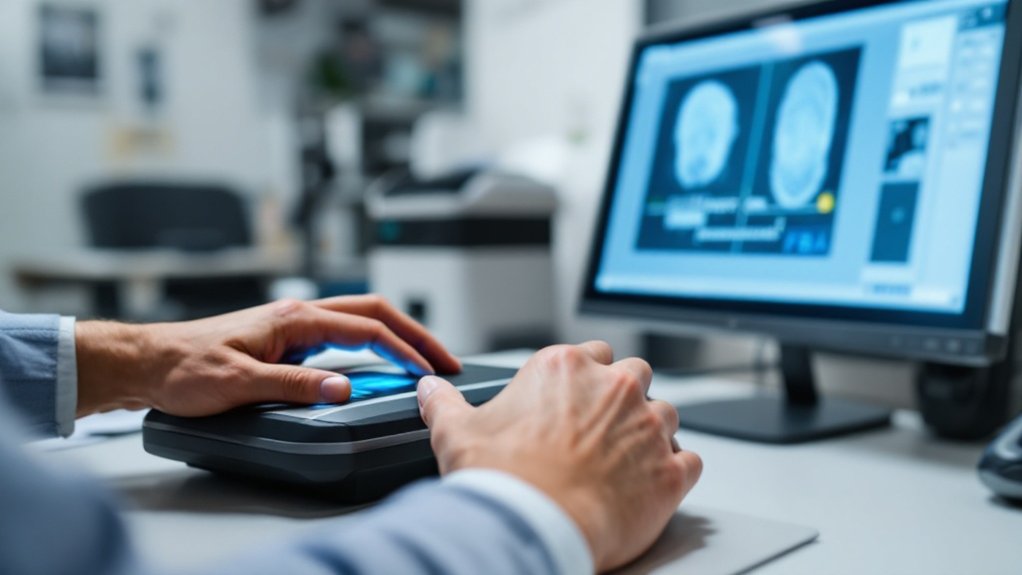
How do you guarantee that the fingerprints you capture are of the highest quality? It starts with proper techniques and tools. Ensuring correct finger placement and preparing fingers by moisturizing or cleaning them can substantially improve image quality. Additionally, using the right scanner ergonomics and providing real-time feedback on image quality are essential.
- Proper Fingerprint Placement: Guide users to place their fingers correctly on the scanner.
- Finger Preparation: Moisturize dry fingers or dry wet ones to enhance image clarity.
- Scanner Maintenance: Regularly clean and maintain scanners to prevent hardware-related issues.
Streamlining the Live Scan Fingerprinting Process
Streamlining the Live Scan fingerprinting process involves leveraging technology to enhance efficiency, accuracy, and security. You can substantially reduce processing time by using electronic submissions, which also minimize errors and provide clearer images. This method is cost-effective, as it eliminates the need for physical materials like ink and paper. Additionally, electronic transmission enhances data security by reducing the risk of document loss or tampering. By utilizing Live Scan technology, organizations can efficiently capture and transmit fingerprints to agencies like the FBI, ensuring faster background check results.
Data Management and Export Options
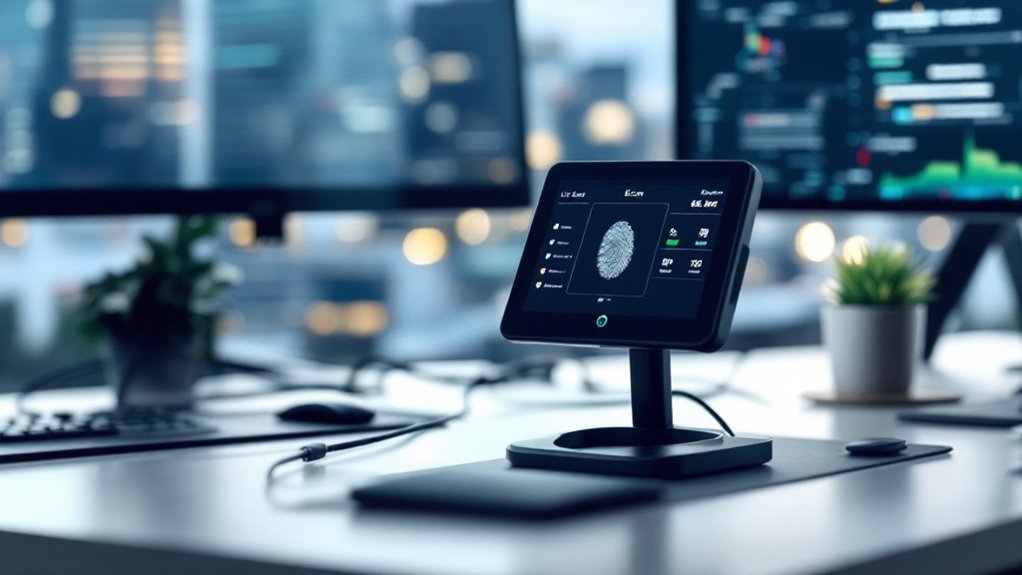
As you optimize the Live Scan fingerprinting process, managing and exporting data efficiently becomes key. Effective data management involves creating and managing high-quality biometric records, facilitating record interchange with state and federal agencies, and ensuring real-time image quality control based on FBI standards.
To export data effectively, consider these options:
- EFT File Export: Export fingerprint data in .EFT format for seamless submission.
- FD-258 Card Printing: Print fingerprints on FD-258 cards for traditional methods.
- EBTS Compliance: Create compliant Electronic Biometric Transmission Specification (EBTS) files for AFIS or ABIS systems.
Implementing Best Practices for Live Scan Operations
As you implement best practices for live scan operations, you’ll focus on maintaining your equipment through regular checks and updates, ensuring data security by adhering to strict protocols and encryption standards, and providing thorough training for operators to enhance their skills in handling live scan devices effectively. By prioritizing these aspects, you can optimize the efficiency and reliability of your live scan operations. Additionally, you’ll need to establish clear guidelines for data management and security, ensuring that all captured biometric data is handled responsibly and in compliance with relevant regulations. Effective live scan operations also require precise positioning, such as placing the device at a height of 44 to 46 inches above the floor to facilitate comfortable fingerprint capture for standing subjects.
Equipment Maintenance
To maintain live scan fingerprinting equipment effectively, you must prioritize regular cleaning and maintenance. This guarantees ideal performance and prevents damage. Here are some key considerations:
- Avoid harsh chemicals: Use gentle cleaning agents to prevent damage to the scanner.
- Prevent scratches: Handle the scanner with care to avoid scratches on the surface.
- Moisture sensitivity: Be cautious in humid environments, as moisture can affect scanner performance.
Regular maintenance helps extend the lifespan of your equipment and secures high-quality fingerprint captures.
Data Security
How effectively do you protect sensitive biometric data when using live scan fingerprinting software? To guarantee data security, you must implement robust measures. Encryption is essential for protecting fingerprint data during transmission, maintaining confidentiality and integrity. Secure transmission to state or federal databases reduces physical breach risks. Strict access controls limit who can view or manage data, enhancing security.
To further safeguard data, use quality control software to verify high-quality images, and consider liveness detection to prevent fake fingerprints. Regular monitoring of system performance helps identify security issues promptly. Secure storage with backups protects against data loss. Adhering to high encryption standards and using secure network protocols like HTTPS also assures data protection. Utilizing live scan technology ensures that fingerprints are captured digitally, eliminating the need for physical ink and reducing the risk of human error in the process.
Operator Training**
Effective operator training is crucial for guaranteeing that live scan fingerprinting operations run smoothly and efficiently. You need to understand FBI standards, be familiar with equipment and software, and know proper hand positioning techniques like the “nail to nail” method. This training helps you guide subjects effectively and maintain continuous updates on best practices.
To enhance your skills, consider these key points:
- Familiarize yourself with live scan devices: Understand how to use them effectively.
- Master proper hand positioning: Confirm even pressure for high-quality prints.
- Stay updated with continuous training: Learn about new technologies and best practices.
Maintaining Compliance With Regulations
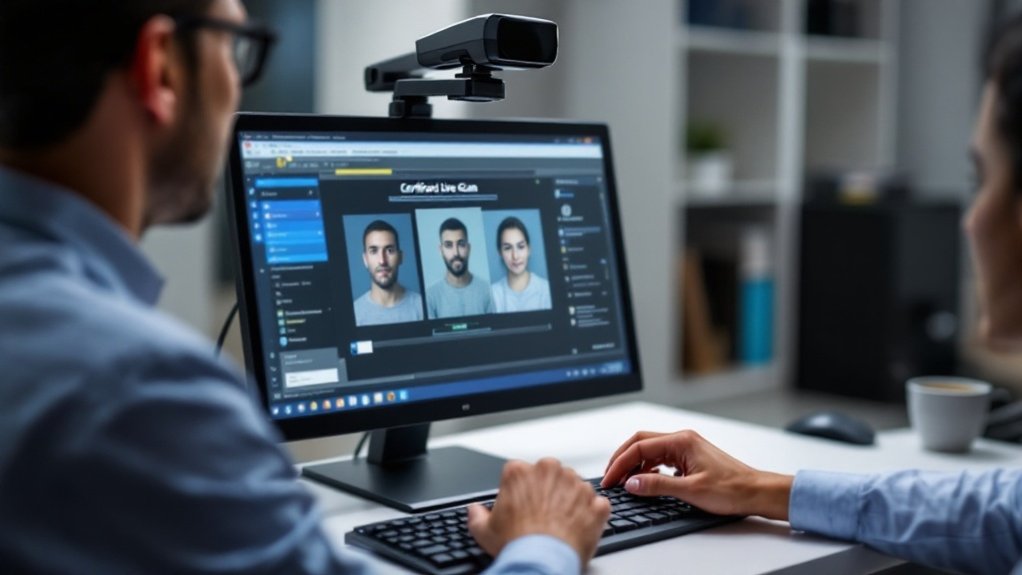
What steps must you take to guarantee that your use of Live Scan fingerprinting software complies with the myriad of regulations governing this technology? You need to stay updated on both state and federal laws, confirming you obtain proper authorization and follow data protection procedures. The FBI’s CJIS Security Policy is indispensable for handling fingerprint data securely. Additionally, you must use certified FBI IAFIS live scan equipment to maintain interoperability with law enforcement systems.
To further safeguard compliance, you should regularly audit your equipment and processes to protect fingerprint data and prevent privacy violations. Secure storage and disposal of images are also essential. By following these guidelines, you can avoid fines and legal consequences while maintaining a reputable service.
Optimizing Live Scan Systems for Efficiency**
Optimizing Live Scan systems for efficiency involves a multi-faceted approach that enhances both hardware and software capabilities while streamlining operational processes. You can improve efficiency by focusing on several key areas:
- Advanced Hardware: Use devices with features like liveness detection to guarantee fingerprints are from live individuals.
- Streamlined Software: Implement software with real-time image quality checks and step-by-step guides for efficient fingerprint capture.
- Operational Efficiency: Employ certified operators and set up efficient workstations to manage data capture and transmission effectively. This approach ensures that the process supports FBI-certified scanners, which are crucial for verifying identity and capturing fingerprints accurately.
Conclusion
You’ve mastered the art of using live scan fingerprinting software effectively, making it a finely tuned engine that drives your operations forward. By choosing the right equipment, selecting compatible software, and ensuring quality control, you’ve optimized your system for efficiency. Now, maintain this momentum by staying compliant with regulations and continually updating your skills to keep your live scan process running smoothly.

